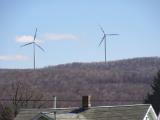
Wind
In recent years, wind has become one of the country’s fastest growing sources of renewable energy. Pennsylvania is host to several wind turbine manufacturing plants and corporate headquarters, making it a leader in the industry. Wind energy development has been spurred by its potential to reduce carbon emissions, promote new manufacturing jobs, and increase energy independence. Technological advances have expanded the size and efficiency of wind turbines during the past decade. This, together with state and federal incentive programs, has facilitated wind development in Pennsylvania, which otherwise ranks relatively low among states for its potential wind generation capacity. The eight turbines installed next to the Pennsylvania Turnpike in Somerset County a decade ago have grown to nearly 500 turbines, with more permitted for construction. Topography is a key factor in average wind speeds across Pennsylvania, so nearly all turbines have been built on mountain ridgelines or on top of high elevation plateaus.
Wind energy has become the most symbolic icon of the shift toward a low carbon economy. With no direct carbon emissions or water consumption, it is one of the cleanest renewable energy types. Communities across the state benefit economically as rural landowners lease their properties, skilled jobs are created to manufacture turbines, and workers are hired to install and maintain turbines. Wind development has faced controversy in some areas from neighboring landowners and those worried about impacts to migrating birds and bats. The wind energy industry, government agencies, and independent researchers are working to better understand these impacts, and in doing so, have discovered Pennsylvania’s second largest Indiana bat maternal colony and a variety of previously undocumented foraging and roosting locations for the state’s two rarest bats (Indiana and eastern small-footed).
Several steps have been taken to address potential conflicts between wind development and wildlife in Pennsylvania. The Pennsylvania Game Commission has a voluntary agreement in place with most wind companies active in the state to screen proposed facilities for possible impacts to birds and bats and migratory pathways. Participating wind companies carry out pre-construction monitoring for birds and bats. If possible conflicts are identified, PGC works with wind companies to avoid or minimize impacts and to continue monitoring post construction in some cases. Second, the Pennsylvania Wind and Wildlife Collaborative (PWWC) was established in 2005 with a state goal to develop a set of “Pennsylvania-specific principles, policies and best management practices, guidelines and tools to assess risks to habitat and wildlife, and to mitigate for the impact of that development.”
- Based on the “Pennsylvania Energy Impacts Assessment"





